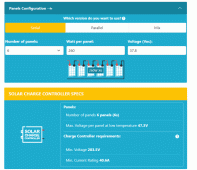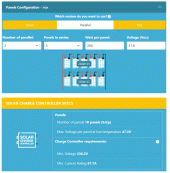Hi,
I am piecing together a small "emergency" backup system, and intend on doing so with minimal expense. Today, I picked up 6 Used REC260PE Z-LINK 260 watt panels for $400 for ~ 1,500 watts of input. I bought used also because I live in Texas, and we are very prone to large hail storms which results in getting a new roof every 8-10 years paid for by insurance, so there is a strong chance I will be replacing panels as needed before 10 years . Yes, I do plan on racking these on the rear roof of my house facing South. All of the panels I purchased test good, and are in great cosmetic condition, and these used panels are making the rounds on the web having favorable reviews and produce on average 98% of their original rated power.. All came from a large Military installation and about 5 years old.
SPECIFICATIONS:
REC PEAK ENERGY Z-LINK SERIES
REC260PE Z-LINK
PEAK POWER: 260 W
RATED VOLTAGE: 30.7 V
RATED CURRENT: 8.50 A
OPEN CIRCUIT VOLATGE: 37.8 V
SHORT CIRCUIT CURRENT: 9.01 A
MAX SYSTEM VOLTAGE 600 V
MAX SERIES FISE 15 A
FIRE RATING: CLASS C
TYPE: POLYCRYSTALLINE SILLICON
DIMENSIONS: 65.55" X 39.02" X 1.5"
WEIGHT: 40 LBS
For inverter, MPT, and charge controller, LifePo4 .. I am simply thinking about picking up an EcoFlow Delta Pro (as an all in one), that I can keep inside in a climate controlled environment when not in use, and roll it out when needed. https://us.ecoflow.com/products/delta-pro-portable-power-station
EcoFlow Delta Pro Solar charge specifications:
Given the panels I purchased, and attempting to maximize Solar charge, what panel arrangement should I consider? No need for inverters as charge input is DC... Just need a little help with my math to stay under charge spec
2 in series x2 then parallel the 2 groups? 36v X 2 = ~ 72 volts, 1040 watts max, but what about amps?
3 in series would be safe... but kinda underpowered..
Thinking about other options too (not all in one).. I do not care for trying to sell power back (non grid tie), I just want power available at all times with battery (could go with something like an EG4 unit or 2), but those would end up in my garage which can get to be 100 degrees in the summer.
Any suggestions are appreciated..
Thanks!
I am piecing together a small "emergency" backup system, and intend on doing so with minimal expense. Today, I picked up 6 Used REC260PE Z-LINK 260 watt panels for $400 for ~ 1,500 watts of input. I bought used also because I live in Texas, and we are very prone to large hail storms which results in getting a new roof every 8-10 years paid for by insurance, so there is a strong chance I will be replacing panels as needed before 10 years . Yes, I do plan on racking these on the rear roof of my house facing South. All of the panels I purchased test good, and are in great cosmetic condition, and these used panels are making the rounds on the web having favorable reviews and produce on average 98% of their original rated power.. All came from a large Military installation and about 5 years old.
SPECIFICATIONS:
REC PEAK ENERGY Z-LINK SERIES
REC260PE Z-LINK
PEAK POWER: 260 W
RATED VOLTAGE: 30.7 V
RATED CURRENT: 8.50 A
OPEN CIRCUIT VOLATGE: 37.8 V
SHORT CIRCUIT CURRENT: 9.01 A
MAX SYSTEM VOLTAGE 600 V
MAX SERIES FISE 15 A
FIRE RATING: CLASS C
TYPE: POLYCRYSTALLINE SILLICON
DIMENSIONS: 65.55" X 39.02" X 1.5"
WEIGHT: 40 LBS
For inverter, MPT, and charge controller, LifePo4 .. I am simply thinking about picking up an EcoFlow Delta Pro (as an all in one), that I can keep inside in a climate controlled environment when not in use, and roll it out when needed. https://us.ecoflow.com/products/delta-pro-portable-power-station
EcoFlow Delta Pro Solar charge specifications:
Solar Charging Input
1600W Max, 11-150V, 15A DCGiven the panels I purchased, and attempting to maximize Solar charge, what panel arrangement should I consider? No need for inverters as charge input is DC... Just need a little help with my math to stay under charge spec
2 in series x2 then parallel the 2 groups? 36v X 2 = ~ 72 volts, 1040 watts max, but what about amps?
3 in series would be safe... but kinda underpowered..
Thinking about other options too (not all in one).. I do not care for trying to sell power back (non grid tie), I just want power available at all times with battery (could go with something like an EG4 unit or 2), but those would end up in my garage which can get to be 100 degrees in the summer.
Any suggestions are appreciated..
Thanks!




